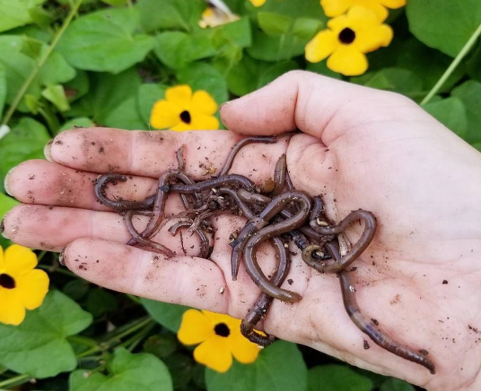by Ken Lain, the mountain gardener
Successful gardening all comes down to the right soil. When plants struggle in the yard, the first step towards better plants starts with a simple soil test. Figure out the soil’s texture, composition, drainage, alkalinity, and minerals, and success skyrockets to your dream garden! Here are four simple, free, do-’em-at-home tests.

Worm Test
Worms are significant indicators of the overall health of garden soil, especially concerning biological activity. If you have earthworms, the chances are you also have all of the beneficial microbes and bacteria that make for healthy soil and vigorous plants. To do the worm test:
#1 At 55 degrees worms become active in the soil; make sure the soil is moist, but not sopping wet.
#2 Dig a hole one foot across by one foot deep and place the soil on a tarp or piece of cardboard.
#3 Count your earthworms as you sift the earth back into the garden hole.
If you find at least ten worms, your soil is in good shape. Less than that indicates you have a problem with a lack of organic matter to support healthy earthworms, or that your soil is just too alkaline.
Percolation Test
Drainage is the number one problem in mountain soils. Most of our evergreens and xeric plants die when the garden stays too wet. Even culinary herbs stop producing when their roots remain wet. To test your soil’s drainage:
#1 Dig a hole one foot across by one foot deep and place the excavated soil on a tarp or piece of cardboard.
#2 Fill the hole with water and let it drain completely.
#3 Fill the hole a second time with water.
#4 Track how long it takes for the water to drain.
If the water takes more than four hours to drain, you have drainage issues that need correcting.
Squeeze Test
One of the most fundamental characteristics of soil is its composition. Soils are classified as either clay, sandy, or loamy. Clay is nutrient-rich, but slow draining. Sand is quick draining but has trouble retaining nutrients and moisture. Loam is considered the ideal soil for its moisture and nutrient holding abilities.
To determine a soil’s type, take a handful of moist soil from your garden, give it a firm squeeze, and open your hand. One of three things will happen:
#1 Shape is held and crumbles when given a light poke = you have rich loam. Perfect!
#2 Shape is held and stubbornly sits in your hand after a light poke = you have clay soil. Not so good.
#3 Your soil falls apart as soon as you open your hand; you have sandy soil. Not good at all.
Now you know what type of soil you have for gardening and can take steps to improve it.
The pH Test
The pH of your soil measures how alkaline or acidic your garden soil is and how happily plants will grow. Most plants grow best in soil with a neutral pH of between 6 and 7. Plants grown in soil pH higher than 7.5 pH turn yellow, lose blossom fragrance or stop blooming all together. Soil needs correcting.
We carry pH test kits here at Watters Garden Center, and they are very easy to find online. Once you know your soil pH is a problem, you can begin working to align the pH~ for optimal growing conditions. If you find you have done these tests, fertilized, and amended your soil as needed, and your garden still struggles, it’s time to enlist the help of a garden center professional.

Watters 58th Spring Open House – consider this a personal invitation:)
March 13 – 15th
We’ve stocked up on fruit and shade trees, blooming shrubs, and flowers for this year’s event. We also are bringing our growers from the farm to share their knowledge with local gardeners. Our 2020 gardens can be started, and this weekend we are celebrating this seasonal return to one of our favorite pastimes!
Until next week, I’ll be helping friends with garden soils here at Watters Garden Center.
Ken Lain can be found throughout the week at Watters Garden Center, 1815 W. Iron Springs Rd in Prescott, or contacted through his web site at WattersGardenCenter.com or FB.com/WattersGardenCenter .

